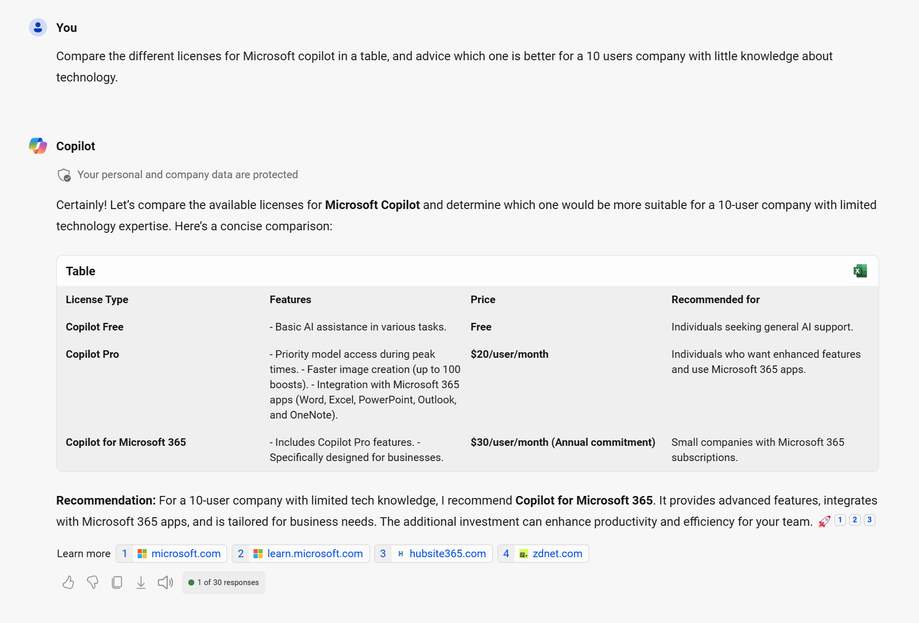Behind the Scenes: Talking AI and Copilot with Microsoft Customer Support Engineers

The Microsoft 365 Commercial Support team resolves customer support cases and provides support to help you be successful and realize the full potential and value of your purchase. Our support services extend across the entire lifecycle and include pre-sales, onboarding and deployment, usage and management, accounts and billing, and break-fix support. We also spend a considerable amount of time working to improve the supportability of Microsoft 365 services to reduce the number of issues you experience as well as minimize the effort and time it takes to resolve your issues if they do occur.
We’re excited to welcome two members from our Microsoft 365 and Windows Commercial Support Engineering team to talk about their journeys with AI and experience assisting commercial customers using Copilot for Microsoft 365.
By now, you’ve probably heard about Copilot for Microsoft 365, your AI assistant that helps you be more productive and creative in your day-to-day work. You and others in your organization may already be using it to write emails, summarize conversations and meetings, and craft stunning presentations. Our Microsoft 365 support teams have been using and getting ready for Copilot for many months and have been helping customers of all types and sizes get the assistance they need so they can stay productive.
Today, it’s my pleasure to welcome two accomplished individuals from our Microsoft 365 Support Engineering team to talk about their own journeys with AI, their experience and insights from supporting commercial customers using Copilot for Microsoft 365, and some of their best practices for implementing AI into support operations.
Ross: Welcome, Nelson and Jagdeesh! Tell us a little about your role, background, and journey into AI in the context of work. What sparked your interest in this field?
Nelson: Thank you, Ross, great to be here! I’m a Partner Technical Advisor working in our Latin America region helping Microsoft 365 support teams deliver world-class support to enterprise customers. I help our support engineers with complex issues, troubleshooting processes and workflow, and so on. I’ve been with Microsoft for 10 years working primarily with Exchange and communications technologies. My journey into AI was driven by my own curiosity and desire to learn new technologies. There are endless capabilities that AI brings to the table, from being able to help you organize your agenda, to providing advice on training to be taken, or ways to accomplish a certain task.
Jagdeesh: Thanks Ross! At Microsoft, I’ve been working for 4+ years mostly with Windows and Azure Networking. I’m currently a Senior Support Engineer on the Windows Commercial team. My interest in AI grew during my time here, especially after getting recognized for some AI-related projects that I’ve worked on. This made me passionate about using AI to make work easier and keep customers happy.
Ross: We'd love to hear about a specific project or experience where you've used AI in your job and where other support engineers could benefit. Could you walk us through a task or project, including the challenges you faced and how you overcame them using AI?
Nelson: While I wouldn't call it a project, I've been using AI to create presentations on how to use AI for our support engineers, where I cover general information, best practices, and examples. The challenges I've faced are mostly related to being able to craft a good prompt to get what you want and to know if you are using the best approach. For instance, I wanted to create a PowerPoint presentation using AI, so at first, I tried to get the code to do it, but then I learned that it is faster and better to create a Word document and then ask Copilot in PowerPoint to create the presentation based on that Word document.
Jagdeesh: One project I led was about making Copilot work better for our engineers. We wanted to create a library of prompts (like questions) that would help them use Copilot more effectively. It was tough at first to make sure the prompts were helpful, and that Copilot understood them well. But by working closely with the engineers and improving the prompts over time, we made things better, and everyone was happier.
Ross: When it comes to integrating AI into operations, what are some of your best practices? How can support professionals and organizations smoothly implement AI while maintaining a high level of customer satisfaction throughout the process?
Nelson: The first question to answer is "What are we trying to fix or improve by using AI?" Based on that, you will train your AI with that goal in mind. A couple of other points to consider:
- Garbage in/garbage out rules apply. It’s paramount to use a curated data set to teach your AI. If the source is bad (inaccurate, low quality) then the output will be bad. Imagine you only teach AI about the world up to the year 2000, then you expect to get information on something that happened in 2020. It will not be good at that.
- Also, it is very important to use different sets to train and test on to make sure the model behaves up to expectations.
- Make sure there’s a close relationship between your support and development teams where they collaborate and hear each other. Sometimes what developers imagine isn’t what users want to do.
- Identify some key people in your organization to work as champions – essentially the super users and early adopters who will help evangelize, train, and excite the rest of the team and get them using.
Jagdeesh: When using AI, it’s important to have clear goals and ways to measure success against a baseline. Engaging and partnering with users is also important. Involve everyone who might use the AI tool in planning and testing and teach the team how to use the AI tool and be there to answer any questions. Create trust and confidence with the team by explaining how the AI is being used and what’s being done to ensure safety and privacy. Finally, keep an eye on how well the AI tool is performing and working. Prepare to make adjustments and changes if the solution is falling short of expectations.
Ross: Can you share how you’ve handled any privacy and security concerns that folks may have?
Nelson: Transparency is key. Help them understand where the data goes, what the user and organization can control, what the users have access to, and so on. This is a great resource: Data, Privacy, and Security for Microsoft Copilot for Microsoft 365.
Jagdeesh: When we use AI, we need to make sure people’s privacy and information are safe. To help with this, we follow rules about how different types of information can be used and clearly explain to people how information is being used and what’s being done to keep it safe. Nelson shared a great resource link.
Ross: Looking back at your experiences, can you share any valuable lessons you've learned or unexpected insights gained from using AI? Are there any pitfalls or misconceptions that organizations should be aware of when embarking on similar AI initiatives?
Nelson: In my experience, AI is a powerful tool that enhances the skills you already have to take it to the next level. Some of the most valuable benefits I’ve seen are teaching you by making a summary of long text (so the TLDR should not happen often) and enhancing writing skills and speed by quickly adjusting format and tone or word count. Also saving time by not only searching for information but giving you a processed version like in this example:

Even if you are a fast writer and know what to say, AI will save you time and effort with the right prompt and likely generate some new ideas on ways to phrase.
In terms of potential pitfalls or misconceptions, one is that if you are looking to implement AI just to be cool and current, then you might get it wrong if there isn’t a clear vision on what you want AI to achieve for your business. Another is relying on AI too much to try and do everything – back to the point about clear vision and your most important outcomes.
Jagdeesh: From my experience with AI, I believe it’s important to make sure everyone knows why AI is being used and how it is going to help. The other one is ongoing engagement with the individuals who will be using the AI tool to deeply understand their work, needs, and feedback, both in the build and launch phase as well as once the solution is in production. We need to prioritize end-user experience in AI initiatives for sustained effectiveness and user adoption. Also, remember to consider what users need and what is right to do with AI.
Ross: This is great! Thank you both for taking the time to share your insights and experience today. And thank you to everyone who’s read this far. To learn more about Microsoft Customer Service & Support, check out these videos: Microsoft Customer Support Agent Webinar.
Jagdeesh Gopal is a Senior Support Engineer in the CSS Windows commercial support team.
Nelson Riera is a Partner Technical Advisor in the CSS Modern Work commercial support team.
Ross Smith is the Worldwide Support Leader for the CSS Modern Work Supportability team.
The CSS Modern Work Supportability team delivers innovative self-help solutions and diagnostics, in-service enhancements, and support programs to help customers get maximum value from their Microsoft 365 commercial subscriptions and create an easy-to-use, connected support experience.
Published on:
Learn more


